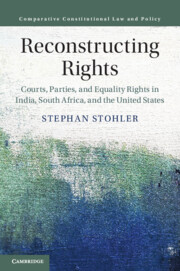 Reconstructing Rights
Reconstructing Rights from Part II - United States of America
Published online by Cambridge University Press: 09 July 2019
Shortly after its adoption, progressive reformers recognized substantial shortcomings of Title VII of the Civil Rights Act of 1964 governing employment discrimination. To overcome these limitation, members of the Democratic Party worked with aligned justices on the Supreme Court to develop evolving understandings of Title VII to support racial minorities seeking to access the federal judiciary and to reduce the evidentiary burdens necessary to prevail at trail. These progressives also supported willing employers' efforts by protecting affirmative action. Conservatives on the bench and in the elected branches aligned with the Republican Party worked in a deliberative fashion to counter these efforts. But, as is true for both coalitions, when justices introduced novel positions that went beyond the interests of their elected counterparts, they relinquished their novel doctrinal positions, which is consistent with the deliberative partnership thesis.
To save this book to your Kindle, first ensure no-reply@cambridge.org is added to your Approved Personal Document E-mail List under your Personal Document Settings on the Manage Your Content and Devices page of your Amazon account. Then enter the ‘name’ part of your Kindle email address below. Find out more about saving to your Kindle.
Note you can select to save to either the @free.kindle.com or @kindle.com variations. ‘@free.kindle.com’ emails are free but can only be saved to your device when it is connected to wi-fi. ‘@kindle.com’ emails can be delivered even when you are not connected to wi-fi, but note that service fees apply.
Find out more about the Kindle Personal Document Service.
To save content items to your account, please confirm that you agree to abide by our usage policies. If this is the first time you use this feature, you will be asked to authorise Cambridge Core to connect with your account. Find out more about saving content to Dropbox.
To save content items to your account, please confirm that you agree to abide by our usage policies. If this is the first time you use this feature, you will be asked to authorise Cambridge Core to connect with your account. Find out more about saving content to Google Drive.